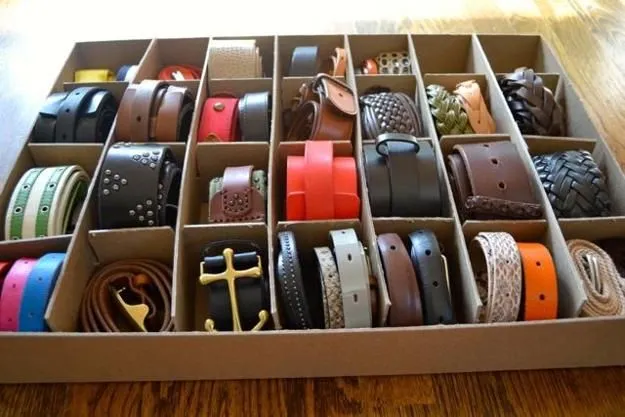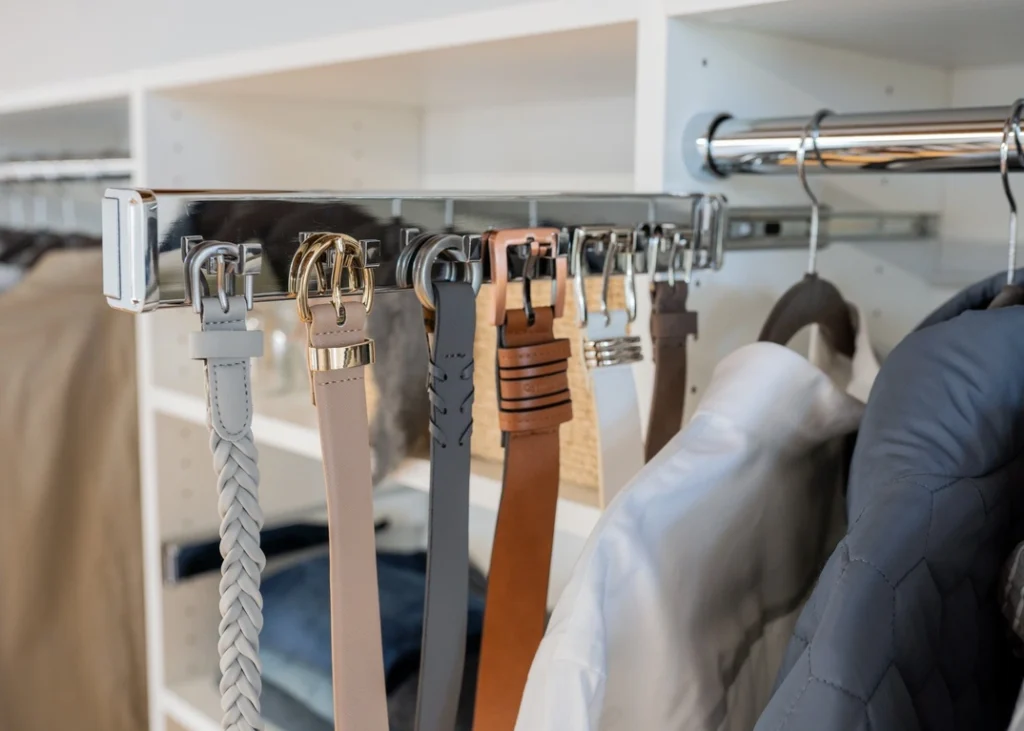A belt adds more than fashion appeal; it defines your appearance and solidifies your ensemble. The storage of your belts, whether leather or fabric or any statement typ,e requires proper maintenance because good storage preserves their quality together with appropriate shape and durability. Keeping belts either tucked away in drawers or hung from door knobs creates damage that progresses to wrinkles and destruction of the material structure. Learning proper methods of how to store belts, it help you organize your belts efficiently and provides instant access to them alongside excellent care quality.
Choosing the Right Storage Method
There is no universal approach to belt storage. The best approach depends mainly on your material type, environmental space, and personal choice. The general population prefers hanging belts for their ease of reach, and the rest choose rolling and folding methods to make space utilization more efficient. Assessing the various storage approaches enables you to sustain the peak condition of your belts.
Hanging belts are particularly useful because they provide easy convenience and protection against deep creases. Wrong hook usage and belt overpopulation result in harmful warping effects. A rolling storage mechanism works excellently with soft fabric and flexible belts that do not develop lasting bends. Care is essential to prevent unwanted wrinkles when storing folded belts with thick leather construction. Stay with us for a better understanding of how to store belts!
Best Storage Solutions for Different Belt Types
Belt materials, and design elements influence how they should be stored because different materials have distinct storage requirements. To prevent creasing leather belts should be hung while fabric and elastic belts can be safely rolled for storage. Heavy-duty and embellished belts should always rest flat to stop them from developing misshapen forms. Storing your belts properly protects their structure and extends their life while preserving their visual appearance.
Clever Storage Hacks to Preserve Your Leather Belts
Leather belts require extra knowledge and care of how to store belts because they are prone to drying out and cracking. They must be stored in a cool, dry place away from direct sunlight. Hanging them on a belt rack or using a specially designed hanger prevents folding creases. If you prefer rolling, ensure the belt is loosely coiled to avoid stress on the leather.
Fabric & Woven Belts: The Best Ways to Store Them
Fabric and woven belts are more flexible than leather belts and can be rolled or folded without causing long-term damage. Using drawer dividers or small fabric boxes helps keep them neatly organized. To prevent fraying, avoid excessive bending or stuffing them into tight spaces.
The Ultimate Belt Showdown: Dress vs. Casual
Dress belts are often thinner and more refined, requiring careful storage. A dedicated belt hanger or a pull-out belt rack is the best option to keep them pristine. Casual belts, including canvas and elastic belts, can be rolled and stored in a drawer or organizer without concern for creases.
Creative Storage Ideas for Small Spaces
Not everyone has a spacious wardrobe, but that doesn’t mean belts must be tangled. Wall hooks or dedicated belt racks offer a space-saving solution while keeping belts visible and easily accessible. Over-the-door organizers, like hanging shoe pockets, provide a simple way to store belts while allowing you to see each one at a glance. For a clutter-free approach, rolling belts into drawer dividers or small storage boxes keeps them neatly separated and tangle-free. With these creative solutions of how to store belts, you can maximize space while keeping your belts in perfect order!
Creative DIY Ways to Store Your Belts
If you love repurposing household items, these DIY hacks offer budget-friendly ways to keep your belts organized. Shower curtain rings, S-hooks or old tie racks can be transformed into efficient belt storage solutions. A sturdy clothes hanger with attached S-hooks provides a space-saving way to store multiple belts neatly in your closet. Upcycle an old towel rack or decorative rail into a stylish belt display for a creative touch, combining functionality with a unique aesthetic. With these simple DIY tricks, you can keep your belts accessible and well-organized without spending a fortune!

How to Prevent Belt Damage
Regardless of how to store belts, taking extra precautions ensures they remain in top condition for years. Here are some key tips:
Avoiding Creases & Cracks: Never fold belts at sharp angles or store them in overly tight spaces. Leather belts, in particular, should be kept flat or hung to prevent cracks.
Protecting Against Moisture & Humidity: Store belts in a dry environment, away from damp conditions that can cause mold or mildew, particularly for leather belts.
Proper Cleaning Before Storage: Wipe down belts with a soft cloth and condition leather belts regularly to keep them from drying out or accumulating dust.
You Might Also Like: How To Clean Yellowed Headlights
Traveling with Belts: Packing Tips
When traveling, improper packing can leave your belts misshapen or tangled. To avoid this, follow these simple packing methods:
Rolling vs. Folding for Luggage: Rolling belts keep luggage compact and prevent harsh creases, making it easier to pack in suitcases or travel organizers.
Protecting Buckles from Scratches: To prevent scratches, wrap the buckle in a small cloth or sock before placing the belt in your bag.
Common Mistakes to Avoid While Storing Belts
- Overcrowding the Storage Space: Storing belts too tightly can cause deformation, especially for leather belts.
- Ignoring Moisture Control: Storing belts in damp places can lead to mold growth and material deterioration.
- Skipping Regular Cleaning: Dust and dirt buildup can shorten the lifespan of belts, especially if stored without proper cleaning.
- Hanging on Improper Hooks: Thin hooks can create pressure points that distort the belt shape over time.
- Not Rotating Belt Use: Constantly wearing and storing the same belt while neglecting others can lead to uneven wear and damage.
Frequently Asked Questions
How To Store Belts In A Small Closet?
Use wall hooks, a belt rack, or over-the-door organizers to save space.
Can I Use A Regular Hanger For Belts?
Yes, use a clothes hanger with S-hooks for easy access and organization.
How Do I Store Belts While Travelling?
Roll belts to prevent creases, and wrap the buckle in cloth to protect it.
Conclusion
By implementing the proper storage techniques for how to store belts, you can keep your belts looking stylish and well-maintained for years to come. Whether you prefer hanging, rolling, or using space-saving storage hacks, keeping your belts organized ensures they are always ready to complement your outfits. Proper care and maintenance enhance longevity and help preserve the quality and appeal of your belts, making your collection more versatile and accessible.




[…] You Might Also Like: How To Store Belts […]